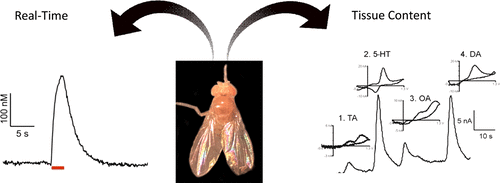当前位置:
X-MOL 学术
›
ACS Chem. Neurosci.
›
论文详情
Our official English website, www.x-mol.net, welcomes your
feedback! (Note: you will need to create a separate account there.)
Drosophila as a Model System for Neurotransmitter Measurements
ACS Chemical Neuroscience ( IF 4.1 ) Pub Date : 2018-02-07 00:00:00 , DOI: 10.1021/acschemneuro.7b00456 Mimi Shin 1 , Jeffrey M. Copeland 1, 2 , B. Jill Venton 1
ACS Chemical Neuroscience ( IF 4.1 ) Pub Date : 2018-02-07 00:00:00 , DOI: 10.1021/acschemneuro.7b00456 Mimi Shin 1 , Jeffrey M. Copeland 1, 2 , B. Jill Venton 1
Affiliation

|
Drosophila melanogaster, the fruit fly, is an important, simple model organism for studying the effects of genetic mutations on neuronal activity and behavior. Biologists use Drosophila for neuroscience studies because of its genetic tractability, complex behaviors, well-known and simple neuroanatomy, and many orthologues to human genes. Neurochemical measurements in Drosophila are challenging due to the small size of the central nervous system. Recently, methods have been developed to measure real-time neurotransmitter release and clearance in both larvae and adults using electrochemistry. These studies have characterized dopamine, serotonin, and octopamine release in both wild type and genetic mutant flies. Tissue content measurements are also important, and separations are predominantly used. Capillary electrophoresis, with either electrochemical, laser-induced fluorescence, or mass spectrometry detection, facilitates tissue content measurements from single, isolated Drosophila brains or small samples of hemolymph. Neurochemical studies in Drosophila have revealed that flies have functioning transporters and autoreceptors, that their metabolism is different than in mammals, and that flies have regional, life stage, and sex differences in neurotransmission. Future studies will develop smaller electrodes, expand optical imaging techniques, explore physiological stimulations, and use advanced genetics to target single neuron release or study neurochemical changes in models of human diseases.
中文翻译:

果蝇作为神经递质测量的模型系统
果蝇果蝇是一种重要的简单模型生物,用于研究遗传突变对神经元活动和行为的影响。由于果蝇的遗传易处理性,复杂的行为,众所周知且简单的神经解剖学以及与人类基因的许多直系同源物,生物学家将果蝇用于神经科学研究。果蝇中的神经化学测量由于中枢神经系统较小,因此具有挑战性。最近,已经开发了使用电化学方法测量幼虫和成虫中实时神经递质释放和清除的方法。这些研究已经表征了野生型和遗传突变果蝇中的多巴胺,5-羟色胺和章鱼胺的释放。组织含量测量也很重要,并且主要使用分离。毛细管电泳,通过电化学,激光诱导的荧光或质谱检测,可以方便地从单个果蝇大脑或少量淋巴样品中测量组织含量。果蝇的神经化学研究研究表明,果蝇具有正常的转运蛋白和自身受体,它们的新陈代谢与哺乳动物不同,并且果蝇在神经传递方面具有区域性,生命阶段和性别差异。未来的研究将开发更小的电极,扩展光学成像技术,探索生理刺激,并使用先进的遗传学来靶向单个神经元释放或研究人类疾病模型中的神经化学变化。
更新日期:2018-02-07
中文翻译:

果蝇作为神经递质测量的模型系统
果蝇果蝇是一种重要的简单模型生物,用于研究遗传突变对神经元活动和行为的影响。由于果蝇的遗传易处理性,复杂的行为,众所周知且简单的神经解剖学以及与人类基因的许多直系同源物,生物学家将果蝇用于神经科学研究。果蝇中的神经化学测量由于中枢神经系统较小,因此具有挑战性。最近,已经开发了使用电化学方法测量幼虫和成虫中实时神经递质释放和清除的方法。这些研究已经表征了野生型和遗传突变果蝇中的多巴胺,5-羟色胺和章鱼胺的释放。组织含量测量也很重要,并且主要使用分离。毛细管电泳,通过电化学,激光诱导的荧光或质谱检测,可以方便地从单个果蝇大脑或少量淋巴样品中测量组织含量。果蝇的神经化学研究研究表明,果蝇具有正常的转运蛋白和自身受体,它们的新陈代谢与哺乳动物不同,并且果蝇在神经传递方面具有区域性,生命阶段和性别差异。未来的研究将开发更小的电极,扩展光学成像技术,探索生理刺激,并使用先进的遗传学来靶向单个神经元释放或研究人类疾病模型中的神经化学变化。











































 京公网安备 11010802027423号
京公网安备 11010802027423号